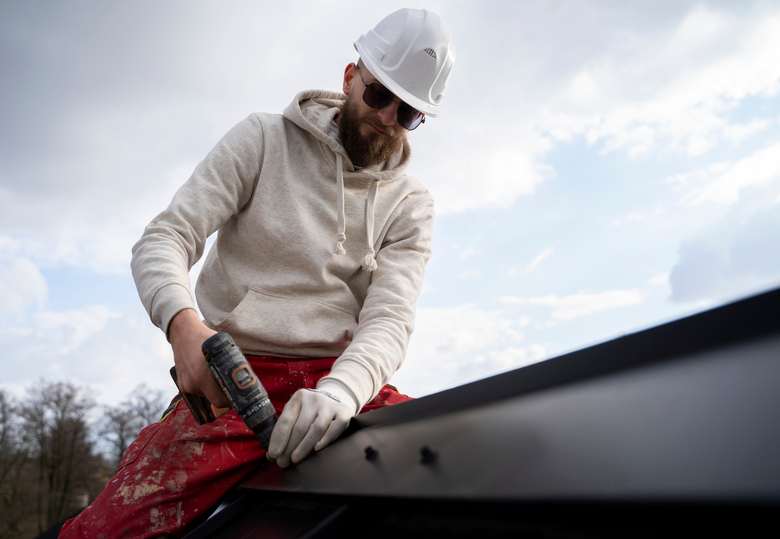What comes to mind when you hear \’leaky roof?\’ How about the classic example of water dripping on someone\’s head while they sleep? A leaky roof can be very dangerous for your entire home if left untreated. Extensive damage can cause water to drip, create mould, and further damage to the foundation. While there are some obvious signs of a leaky roof, do you know all of them? The following will outline the signs of a leaky roof and the top reasons for it. Although we recommend regular roof maintenance, roofing issues can still arise. Contact a professional roofer if you see any of these warning signs.
What Are the Signs Of A Leaky Roof?
First, let\’s go over some obvious signs of a leaky roof as well as the less obvious.
Water Stains
Water stains on the ceiling are one of the easiest ways to detect a leaky roof. These puddle-like stains can be brown or yellow because of mould or algae. Keep an eye out for stains on your ceiling, including the corners of your room. Over time, these stains can cause water to drip, which is why you shouldn\’t ignore any new stain.
Once you fix the leaky roof problem, these stains will remain. Luckily, there are guides on how to remove water stains from your ceiling safely.
Check The Attic
We recommend checking your attic every so often to see if there is any damage. A wet roof deck is one way to see that something isn\’t right. Similar to water stains on your ceiling, you might find them here too.
Mould
Do you smell that? One way of detecting mould is through the musty, unpleasant smell it brings. Mould growth is also a sign of a leaky roof and should be dealt with immediately. You can typically find mould growth in the bathroom or kitchen. However, it isn\’t always visible. Mould from a leaky roof can grow from several places. This includes the attic, exterior walls, or outside where the roof and exterior walls meet. Mould can cause many health concerns, and it is important to find the source as quickly as possible.
Dripping Sounds
You may smell nothing, but do you hear something? Even after you turn off your faucet, you might hear water dripping. This is another indicator of a leaky roof.
Gutters Dripping Water
The gutter and roof go hand in hand, so if one fails, the other is at risk as well. If your gutter is dripping, it means water can\’t properly flow away from the structure. Therefore, water can become trapped on your roof and cause damage. Check if there is any debris blocking the gutters or if they\’re damaged and need replacing.
Why Do I Have A Leaky Roof?
Next, we will highlight four main reasons you have a leaky roof.
Ice Dams
Throughout the winter, we see many freezing and thawing cycles thanks to chinooks. While it\’s nice to see the snow melt away, ice dams can cause roof damage. When the temperature rises, the snow begins to melt. However, the melting won\’t fully make it off your roof. When it later refreezes at the roof\’s exterior edge, this causes an ice dam. Now that we\’re into spring, it\’s a great time to see if ice dams have caused roof damage. For example, ice dams can loosen shingles, tear off your gutters, damage insulation, and damage the roof covering. If you find water damage in your attic, it might have been due to ice dams.
Flashing Issues
Flashing is a thin material typically made of metal that helps to protect many areas of your roof. In other words, think of it as a protective seal that prevents water damage. You can find it around vents, chimneys, walls, roof valleys, and skylights.
We recommend an annual check-up on your roof, which includes assessing the flashing. After a long winter, built-up snow can wear down the material. Damaged flashing might have dents, cracks, or have missing pieces. Rust or small holes are other ways to see whether your flashing has damage. Water can enter through any small crack, so it’s best to contact a professional roofer if you find any of these signs.
Missing Or Damaged Shingles
Shingles are the first line of defence for your roof. Anytime you find missing or damaged shingles on your roof, have them replaced. The sooner you replace shingles, the better. Without them, your roof is exposed and will be less able to handle the elements.
Also, make a note of any buckling shingles. If the shingles look wavy instead of flat, it usually shows poor ventilation in the attic. As we mentioned above, water only needs a small entranceway to cause a lot of potential damage.
Your Roof Is At The End Of Its Lifespan
All roofs have a different lifespan. Depending on the material, it might be time for a replacement. Unfortunately, extensive wear and tear coupled with old age mean a roof replacement or re-roofing is necessary.
A leaky roof won’t always be easily detected, which is why regular maintenance is important. By noting all the key signs of a leaky roof, you can fix the problem before it gets worse.





